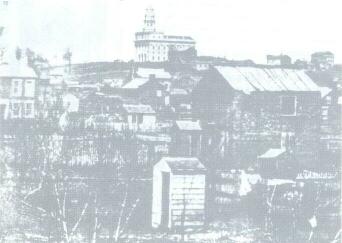 |
Home | Search | Browse | About IPO | Staff | Links |
 |
Home | Search | Browse | About IPO | Staff | Links |
|

Daniel L. Dickens and Robert H. Lombard Elijah Lovejoy, an abolitionist, and Joseph and Hyrum Smith, Mormons, were killed in 1837 and 1844, respectively, because of their unpopular views. In each case, pro-slavery and anti-Mormon groups in Illinois constrained the rights of the minorities. Each raises the question of the rights of minorities under the rule of law and how those rights evolved in Illinois. It is hard to imagine a time when the Bill of Rights did not apply to everyday endeavors. Yet, that was the case when Illinois became a state in 1818; the Bill of Rights applied only to the federal government and not to the governments of the individual states. Individual state constitutions such as the 1818 Illinois Constitution were approved at the national level when states applied for admission into the Union. Each of these constitutions typically contained language similar to that in the federal Bill of Rights. However, those rights were unevenly enforced and conflicts arose, especially on the frontier. Not all settlements were compromises. Democracy was emerging at the time, and it is useful to recall what observers like Alexis de Tocqueville said about democracy on the frontier. Paul Gagnon, the principal investigator of the Bradley Commission, summarizes in Democracy's Half-told Story (1989) the dangers of democracy that de Tocqueville observed during his visit to America during the 1830s:
Tocqueville saw grave danger of four kinds. First, the tyranny of the majority would discourage independent thought and be hostile to contrary or complicating ideas. Second, and closely related, egalitarian envy—the very engine of democracy, Tocqueville called it—would hurry to support mass opinion. Rather than allowing some people the liberty of being different, envy would choose equality "in servitude" over inequality in freedom. Third, rising economic opportunity, indisputably desirable in itself, would stir an appetite for personal gain in the short run, tempting men to forget the ideals of the past, to ignore the needs of the future, and to withdraw from public affairs to their own private spheres. Lastly, while evading the chores of politics, men would seek the aid of government in their own private interests, thus encouraging both the expansion and corruption of political power. While the cynic might find evidence of each of these dangers in our times, the first two apply to the events in Alton and Nauvoo.
Elijah Lovejoy divided his time on the frontier between editing a newspaper and ministering to a Presbyterian congregation in St. Louis. He used his paper, the St. Louis Observer, to attack gambling, drinking, tobacco use, and slavery. After Lovejoy wrote an editorial condemning both the lynching of a slave accused of murder and the justice system, a mob assembled, smashed his press, and threw the pieces into the Mississippi River. Lovejoy then left Missouri for a new future in Alton, Illinois. Illinois was a free state, although many residents were pro-slavery because they had moved to the state from areas in which slavery existed. Economics tied Illinois closely to slave states along the Mississippi River. Lovejoy's luck was no better in Alton. The citizens of Alton knew his reputation as an abolitionist, and his first press was smashed while still on a dock, and the pieces were thrown into the river. Another press served for a few months, but after Lovejoy called for the formation of an Illinois Anti-Slavery Society in 1837, his press was again destroyed. Lovejoy ordered another press, and he organized a local society against slavery. A meeting was held in Alton, with more pro-
19
slavery people attending than abolitionists. The Illinois attorney general even attended and spoke against Lovejoy. Tensions increased until the fourth of Lovejoy's presses arrived. A mob destroyed it while it was still in the warehouse. Lovejoy ordered another press, which arrived at 3:00 a.m. on November 7, 1837. By that evening a mob gathered and approached the warehouse. Shots were fired. Lovejoy was murdered and his press destroyed. Trials were held for both those in the mob and those protecting the press. Little was remembered by the witnesses, and all were found not guilty.
De Tocqueville's concept of the tyranny of the majority applies to the arrival of the Mormons in Illinois. After being driven from Missouri in the winter of 1838-39, the Mormons established themselves in Hancock County, Illinois. Resentment grew quickly, and opinions in the county were split for and against the Mormons. Nauvoo's population rose quickly, reaching more than 20,000 by 1844. As Mormon political strength grew in the county, it attracted interest from state political leaders as well. The success of the Mormons created resentment, and Hancock County splintered into two armed camps. When a newspaper in Nauvoo, The Expositor, challenged the political and religious views of Mormon leaders Joseph and Hyrum Smith, the city council declared the paper a nuisance and the press was destroyed by the Nauvoo militia. The worst fears of the non-Mormon population of Hancock County were confirmed. Warrants were issued for the Smiths' arrest for their role in the destruction of the press, and the two men were taken to the Carthage jail. Although Governor Ford assured the Smiths that they would be safe, a group of militia from Warsaw entered the jail on June 27,1844, and killed the Mormon leaders. The Carthage militia had somehow "gone a missing" when they were needed to protect the jail, and nearby forces arrived too late to help. Since the Smiths died while in custody, indictments were issued for nine men. Five of the accused conspirators stood trial in Carthage. All were found not guilty. The violence in Hancock County continued, and the Mormons eventually were forced to move further west.

Click Here for Curriculum Materials 20 |
|
|